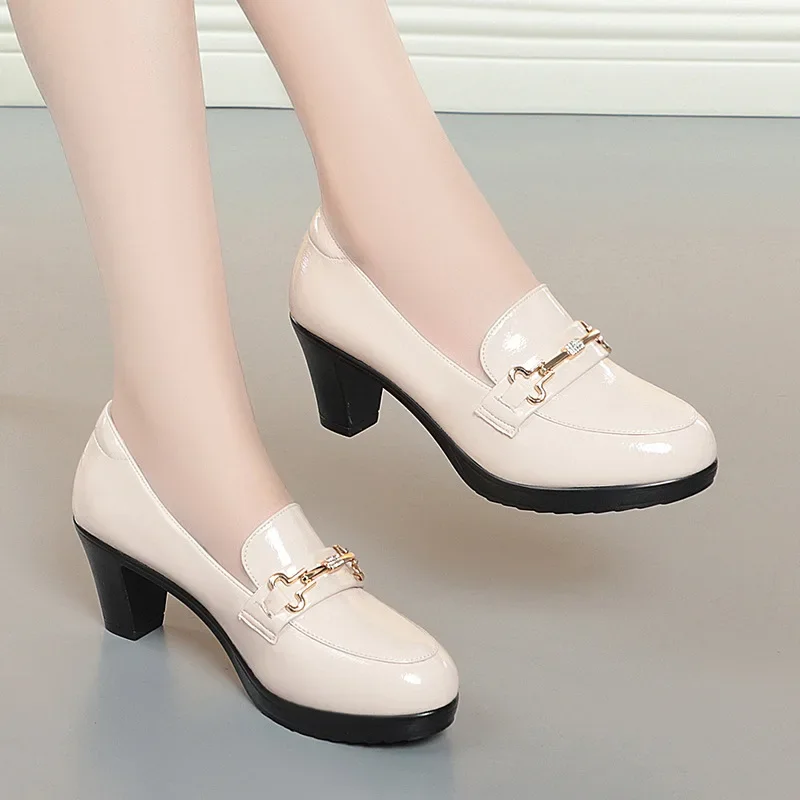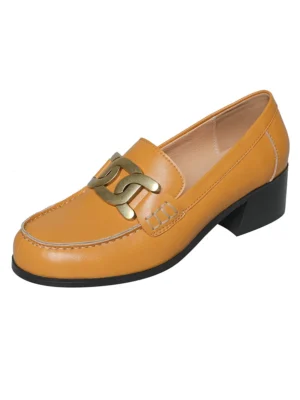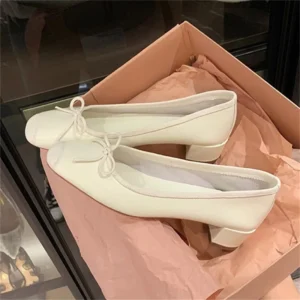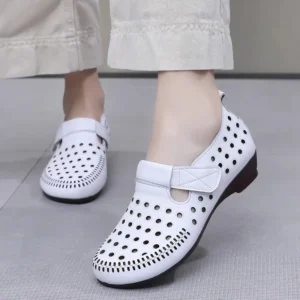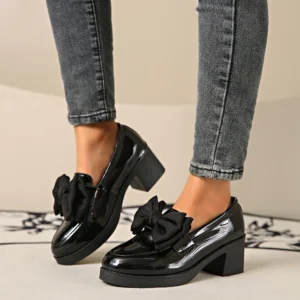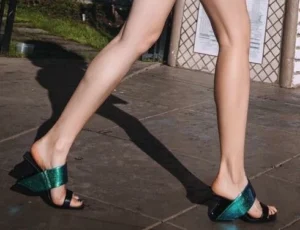Why Block Heel Work Loafers Deserve a Place in Your Professional Wardrobe
Finding the perfect work shoe can feel like an impossible quest. Many professionals struggle with uncomfortable flats that offer little support or traditional high heels that cause pain after just a few hours. Block heel work loafers solve this dilemma by perfectly balancing professionalism, comfort, and style.
These versatile shoes address the most common workplace footwear challenges. Their moderate heel height provides the polished elevation of traditional pumps without the instability, while their loafer styling offers more structure and support than basic flats. According to workplace wellness studies, nearly 70% of professionals report foot discomfort affecting their productivity, highlighting the importance of proper footwear choices.
What makes block heel loafers particularly valuable is their adaptability across various professional environments. They transition seamlessly from conservative corporate settings to creative offices, and from client meetings to after-work events. This versatility makes them an exceptional investment piece for any professional wardrobe.
In this comprehensive guide, we’ll explore the three essential pillars of quality block heel work loafers: comfort features that support you through long days, professional aesthetics that enhance your workplace presence, and durability factors that ensure your investment stands the test of time. Creating professional office loafer outfits becomes effortless when you understand these key elements.
Essential Comfort Features for All-Day Professional Wear
Comfort isn’t just about feeling good—it’s about performing at your best. Research consistently shows that physical discomfort directly impacts concentration, decision-making, and overall workplace productivity. When it comes to work footwear, investing in proper comfort features isn’t a luxury but a professional necessity.
Quality block heel work loafers stand apart from ordinary shoes through several key comfort elements:
- Optimal heel design – The ideal block heel provides 1-3 inches of height with a substantial base that distributes weight evenly, reducing pressure on the ball of the foot by up to 30% compared to stilettos
- Advanced cushioning – Premium loafers feature memory foam, gel inserts, or multi-density footbeds that absorb impact and provide continuous support throughout the day
- Strategic arch support – Properly designed internal structures prevent overpronation and reduce the risk of plantar fasciitis, a common complaint among professionals who stand or walk frequently
- Breathable materials – Quality loafers incorporate moisture-wicking linings and perforated insoles to maintain comfortable temperature and prevent odor development during long workdays
- Balanced flexibility – The best work loafers allow natural foot movement while providing sufficient structure, striking the perfect balance between support and mobility
Understanding are block heels good feet is essential when selecting professional footwear that won’t compromise your comfort or health during demanding workdays.
The Foundation: Heel Design and Stability
The block heel serves as the literal foundation of these professional shoes, and its design significantly impacts overall comfort and wearability. The optimal height for workplace block heels typically falls between 1.5-2.5 inches—tall enough to provide leg-lengthening benefits and professional elevation without creating excessive pressure on the forefoot or compromising stability.
What truly sets block heels apart is their substantial base width. Unlike narrow heels that create pressure points and balance challenges, quality block heels distribute body weight more evenly across a broader surface area. This structural advantage translates to approximately 30% less pressure on the ball of the foot compared to narrower heel designs, allowing for comfortable all-day wear without the typical fatigue associated with heeled shoes.
The placement of the heel relative to the overall shoe design also matters significantly. Well-designed block heel loafers position the heel directly under the natural heel of the foot rather than set back, which maintains proper posture alignment and prevents the forward-sliding pressure common in poorly designed heeled shoes. Exploring various women’s block heel loafers reveals how different brands approach this critical structural element.
Cushioning Technologies That Prevent Fatigue
The invisible interior components of block heel loafers play a crucial role in preventing the foot fatigue that commonly occurs during long workdays. With each step, the human foot absorbs impact forces equivalent to 1-2 times body weight—forces that multiply throughout an 8+ hour workday.
Advanced cushioning technologies address this constant stress through specialized materials and strategic placement:
- Memory foam insoles conform to individual foot contours, providing personalized support that reduces pressure points by up to 40% compared to standard footbeds
- Gel cushioning elements, often placed at the heel and ball of foot, absorb and distribute impact forces that would otherwise transfer to joints
- Multi-layer systems combine different density materials to provide both immediate comfort and long-term support that maintains its effectiveness throughout the day
- Removable footbeds allow for customization or replacement as cushioning compresses over time, extending the comfort lifespan of the shoes
The most effective cushioning systems work in harmony with the shoe’s structure rather than as isolated components, creating a comprehensive comfort experience that supports professional performance.
Toe Box Design for Pain-Free Movement
While heel design often receives the most attention, the front portion of work loafers is equally critical for all-day comfort. The toe box—the area that houses your toes—must strike a delicate balance between professional appearance and functional space for natural toe splay and movement.
Different toe box shapes accommodate varying foot anatomies. Square toe designs provide the most room for toes to spread naturally, making them ideal for wider feet or those with conditions like bunions. Round toe boxes offer a classic look with moderate space, while almond shapes create a sleeker silhouette but typically provide less room for toe movement. Understanding these variations helps professionals select women’s round toe flat loafers or other styles that best accommodate their unique foot structure.
Proper toe box design prevents common workplace foot issues including nerve compression, friction blisters, and nail problems that can develop when toes are cramped throughout long workdays. When evaluating potential work loafers, ensure you can wiggle your toes freely and feel no pressure points across the widest part of your foot.
Flexibility and Movement: The Sole Connection
The soles of quality block heel loafers must balance seemingly contradictory needs: providing structure and support while allowing natural foot mechanics during walking. This critical component forms the literal interface between your body and the ground, influencing everything from energy expenditure to joint alignment.
Well-designed work loafer soles incorporate strategic flexibility zones—areas that bend in alignment with the foot’s natural hinge points, particularly at the ball of the foot. These targeted flexibility features reduce the muscle effort required for walking, decreasing overall fatigue. Simultaneously, quality professional loafers provide torsional stability (resistance to twisting) through reinforced midfoot structures that support proper alignment.
Professional-appropriate outsoles also feature workplace-specific performance elements: slip-resistant patterns that maintain traction on smooth office surfaces, shock-absorbing compounds that protect joints during commutes, and noise-dampening designs that ensure quiet movement through professional environments. These seemingly small details significantly impact both comfort and workplace functionality.
Professional Aesthetics: Style Elements for Workplace Success
Beyond comfort, the visual impact of your footwear plays a significant role in professional environments. Research in workplace psychology confirms that appearance directly influences perception, with footwear serving as a surprisingly powerful indicator of attention to detail, professionalism, and competence. Well-chosen work loafers contribute meaningfully to your overall professional presence.
Quality block heel loafers convey sophistication through clean, intentional design rather than flashy elements. The hallmarks of professional loafer aesthetics include streamlined silhouettes with minimal excess material, precise proportions that create visual harmony, and thoughtful finishing touches that demonstrate attention to detail. The most versatile professional loafers balance contemporary relevance with classic elements that transcend seasonal trends.
The aesthetic impact extends beyond the shoes themselves to how they interact with your professional wardrobe. Well-designed block heel loafers create balanced proportions with trousers, skirts, and dresses, elevating simple outfits while complementing more formal ensembles. Learning how wear loafers office environments helps professionals maximize this versatility.
Color Selection for Maximum Versatility
Strategic color selection dramatically impacts the versatility and professional appropriateness of block heel loafers. The most workplace-efficient approach prioritizes core neutral shades that coordinate seamlessly with multiple outfits, maximizing the utility of your footwear investment.
Black remains the quintessential professional color, offering unmatched versatility and appropriateness across virtually all workplace environments. Navy provides a sophisticated alternative that pairs beautifully with both warm and cool color palettes while appearing less severe than black. Rich browns and taupes create warmth and pair exceptionally well with earth-toned professional wear.
The professional setting should guide color selection beyond these versatile neutrals. Traditional corporate environments generally favor conservative colors with minimal contrast, while creative industries often permit deeper tones or subtle accent colors. When expanding beyond core neutrals, consider shades like burgundy, forest green, or navy that maintain professional sophistication while adding visual interest. Exploring women’s black heeled loafers provides an excellent starting point for building a versatile professional footwear collection.
Material Selection: Balancing Elegance and Practicality
The materials used in block heel work loafers significantly influence both their professional appearance and practical performance. Different materials offer distinct advantages and considerations for workplace environments:
Full-grain leather represents the gold standard for professional footwear, developing a rich patina over time while providing excellent durability and conforming to the foot for personalized comfort. Its natural variations create subtle visual interest while maintaining professional restraint. This premium material requires regular conditioning to prevent drying and cracking but rewards this care with years of professional service.
Patent leather offers high-impact shine appropriate for formal business environments and client-facing roles. Its reflective surface creates a polished appearance that signals attention to detail, though it’s less breathable than standard leather and may show creases more prominently over time. Regular cleaning with appropriate products prevents dulling.
Suede provides sophisticated texture that works especially well in business casual environments. Its matte finish offers a refined alternative to shinier leathers, though it requires protective treatment and regular brushing to maintain its professional appearance, especially in variable weather conditions.
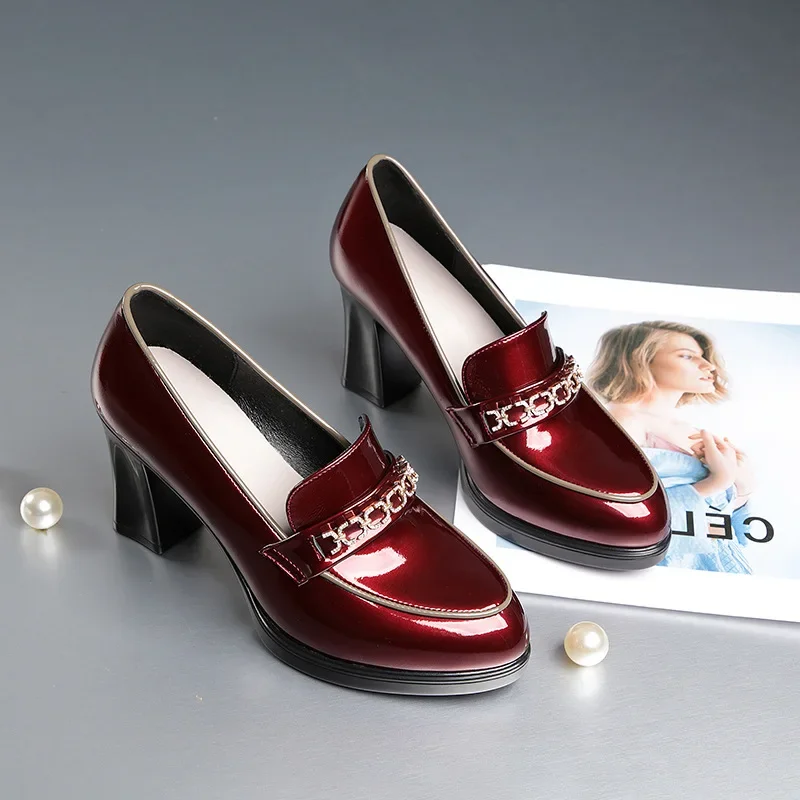
Quality women’s leather heeled loafers represent an investment in both professional appearance and long-term performance, with superior materials directly impacting comfort, durability, and workplace appropriateness.
Professional Detailing: From Classic to Contemporary
The distinguishing details of block heel loafers significantly influence their professional impact while expressing varying levels of personality within workplace-appropriate boundaries. Traditional loafer elements like penny slots, tassels, or kilties carry heritage associations that convey knowledge of professional conventions and attention to established business codes.
Modern interpretations incorporate subtle contemporary elements—minimalist metal hardware, clean seam details, or textural variations—that maintain professional appropriateness while demonstrating awareness of current design language. The most versatile professional loafers feature details with intentional restraint, avoiding overly trendy embellishments that quickly appear dated or elements so prominent they limit outfit coordination.
The appropriate level of detailing varies by workplace culture and role. Client-facing positions in traditional industries generally call for classic, restrained details, while creative sectors often permit more contemporary interpretations. Creating versatile business casual loafer outfits becomes easier with thoughtfully detailed shoes that enhance rather than dominate your professional appearance.
Durability Factors: Investing in Long-Lasting Work Footwear
Professional footwear represents both a financial investment and a practical tool that must withstand significant daily demands. Quality block heel loafers typically command higher initial prices but deliver substantially better value over time through extended usable life and superior daily performance.
The economic advantage becomes clear through cost-per-wear analysis: premium work loafers priced at $180 that last three years of regular wear (approximately 450 wears) cost $0.40 per use. By contrast, lower-quality options priced at $60 might require replacement after just 6-8 months (approximately 120 wears), resulting in a comparable $0.50 per use while delivering inferior comfort and professional appearance.
Beyond simple longevity, durable work footwear offers significant advantages in consistent performance. Quality construction maintains its supportive properties over time rather than deteriorating after limited use, providing reliable comfort throughout the ownership period. This consistency allows professionals to focus on their work rather than being distracted by deteriorating footwear.
Construction Quality Indicators
Several visible construction elements serve as reliable indicators of durability in block heel work loafers:
- Stitching quality – Look for tight, consistent stitches with even spacing and no loose threads. Double or reinforced stitching at stress points indicates attention to durability.
- Heel attachment – Quality loafers feature heels secured through multiple attachment methods, including both adhesives and internal reinforcement. Check for seamless integration between the heel and sole with no visible gaps.
- Interior finishing – Premium work loafers feature clean interior construction with no rough edges, exposed staples, or unfinished materials that could cause discomfort or deteriorate quickly.
- Upper-to-sole connection – Examine how the upper portion connects to the sole. Secure, precisely executed connections through stitching or high-quality bonding indicate durable construction.
Construction quality directly impacts how loafers age during professional use. Superior construction allows shoes to break in and mold to your feet while maintaining structural integrity. By contrast, poor construction often reveals itself through specific failure patterns: separating uppers, detaching heels, or collapsing internal support structures that compromise both appearance and comfort.
Material Durability Beyond Appearances
Surface aesthetics represent just one aspect of material quality in professional footwear. The most durable work loafers incorporate materials selected for performance properties that aren’t immediately visible:
Leather thickness and quality varies significantly, with premium loafers using appropriately substantial materials that resist deformation while remaining flexible. The edge finishing on leather components—often visible around the tongue or topline—reveals attention to detail, with rolled or sealed edges resisting fraying and maintaining shape better than raw-cut materials.
Sole density directly impacts wear resistance, with higher-density materials maintaining their shape and support longer during regular use. Quality professional loafers often feature multi-density soles that place more durable compounds in high-wear areas while using more flexible materials in motion zones.
Interior lining integrity significantly influences both comfort and longevity. Premium work loafers feature securely attached linings made from abrasion-resistant materials that withstand the friction of daily use without tearing or separating from the upper. The ultimate guide womens loafers office environments provides deeper insight into material quality markers that ensure professional performance.
Practical Considerations for Workplace Performance
The specific demands of your professional environment should directly inform your loafer selection. Different workplace scenarios create distinct footwear requirements that impact comfort, performance, and professional appropriateness.
For roles requiring significant standing or walking, prioritize enhanced cushioning systems, shock-absorbing sole materials, and optimized weight distribution through proper heel design. These features become especially important in retail management, healthcare, education, or other positions where movement dominates the workday. In these environments, even small improvements in footwear design can significantly reduce fatigue and discomfort.
Primarily desk-based roles allow more flexibility in design selection but benefit from features that transition well between sitting and movement. Slip-on designs provide convenient on/off capability during long periods at a desk while maintaining professional appearance for meetings or presentations. Weight considerations become less critical, though shoes that provide proper support during periods of sitting help maintain circulation and prevent discomfort.
Women's Block Heel Loafers, Women's Heeled Penny Loafers, Women's Monk Strap Loafers
$194.04 Select options This product has multiple variants. The options may be chosen on the product pageWomen's Block Heel Loafers, Women's Square Heel Loafers, Women's Square Toe Flat Loafers
Price range: $73.61 through $86.41 Select options This product has multiple variants. The options may be chosen on the product pageWomen's Comfortable Flat Loafers, Women's Leather Flat Loafers, Women's Round Toe Flat Loafers
$124.88 Select options This product has multiple variants. The options may be chosen on the product pageWomen's Black Heeled Loafers, Women's Black Platform Loafers, Women's Block Heel Loafers, Women's Chunky Heel Loafers
$72.58 Select options This product has multiple variants. The options may be chosen on the product pageWomen's Block Heel Loafers, Women's Leather Heeled Loafers, Women's Square Toe Flat Loafers
$109.84 Select options This product has multiple variants. The options may be chosen on the product page- $220.29 Select options This product has multiple variants. The options may be chosen on the product page
The transition between different professional contexts—from desk work to client meetings, presentations to commuting—creates unique demands that quality block heel loafers address effectively. Features like secure fit that accommodates different walking speeds, professional appearance from multiple viewing angles, and adaptability to various surfaces make women’s slingback loafers and similar styles particularly valuable for professionals who navigate diverse workplace scenarios.
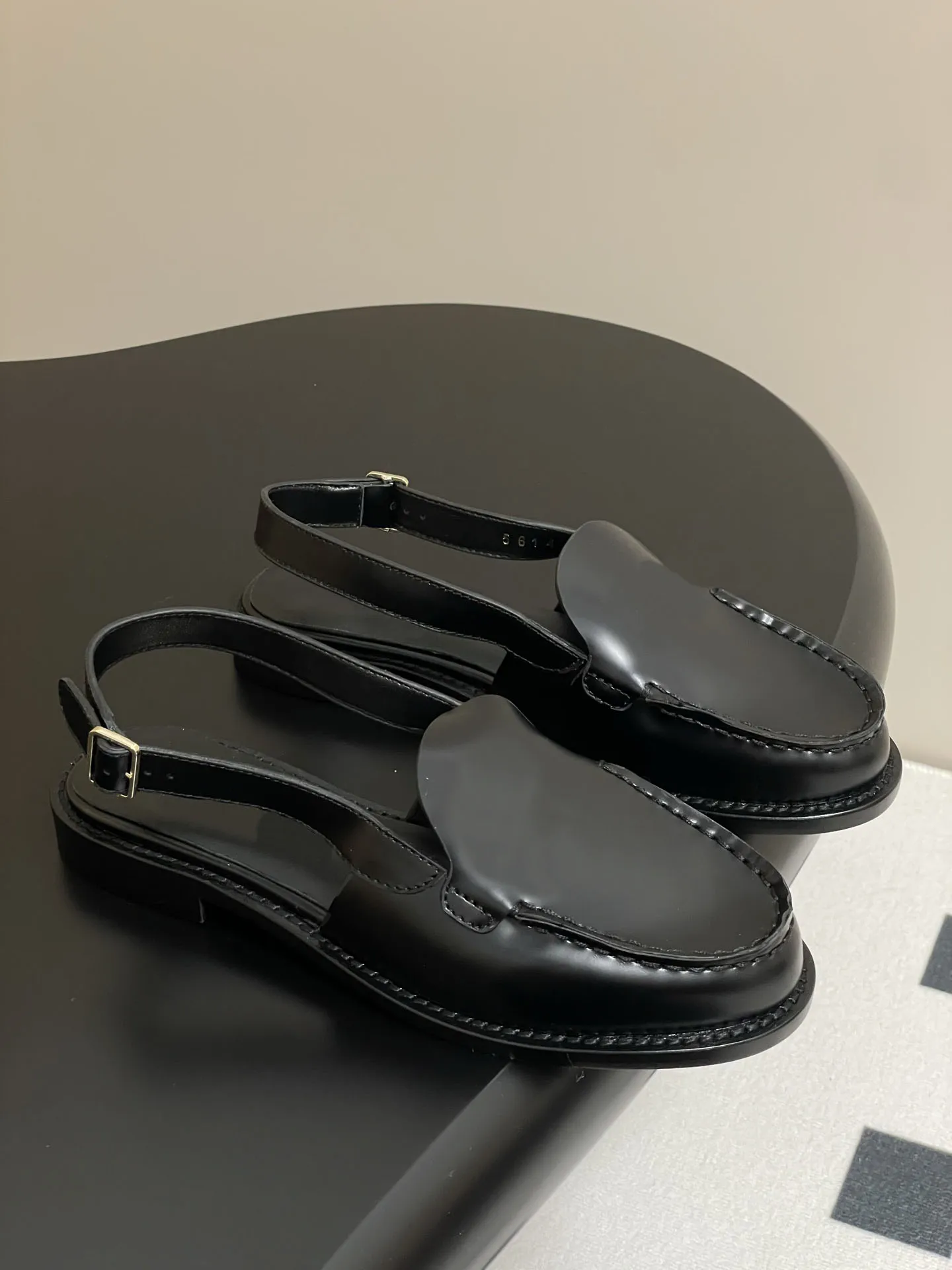
Breaking In Period: What to Expect
Quality leather loafers typically require a breaking-in period as the materials conform to your unique foot shape. This adaptation process creates personalized comfort but requires some understanding and patience during the initial wear period.
Full-grain leather typically needs 5-7 wears to begin softening at flex points, with complete conforming occurring over 15-20 wears in most cases. Patent leather and stiffer synthetic materials may require slightly longer adjustment periods. During this breaking-in time, the internal supports of the shoe also adjust to your gait patterns, creating a customized fit that enhances long-term comfort.
To minimize discomfort during this period, implement a gradual wear schedule beginning with 2-3 hours before extending to full days. Strategic use of appropriate cushioning products in specific pressure areas can ease the transition period. Importantly, distinguish between normal breaking-in discomfort (which diminishes with each wear) and genuine fit problems (which persist or worsen). Properly fitting shoes should never cause sharp pain, severe rubbing, or significant pressure points even during initial wears.
Care and Maintenance for Maximum Longevity
Implementing proper care routines significantly extends the professional lifespan of block heel work loafers while maintaining their workplace-appropriate appearance:
Leather care essentials – Clean leather uppers with appropriate cleaner every 5-7 wears and condition every 10-15 wears to prevent drying and cracking. Allow 24 hours of rest with shoe trees inserted between wears to preserve shape and allow moisture evaporation.
Suede maintenance – Protect suede uppers before first wear with appropriate repellent spray. Brush gently with a suede brush after each wear to restore nap and remove surface dirt before it becomes embedded.
Patent leather upkeep – Clean patent leather with a soft cloth dampened with water or specialized patent cleaner to remove fingerprints and surface residue. Avoid alcohol-based products that can damage the finish.
Preventative measures – Apply protective treatments to soles before first wear to increase water resistance. Address minor damage promptly before it creates structural issues. Use heel caps to prevent uneven wear patterns that can affect gait and comfort.
Professional maintenance services like resoling or reheeling can significantly extend the usable life of quality work loafers, often for a fraction of replacement cost. These services are particularly valuable for footwear with premium uppers that remain in good condition while wear components deteriorate.
Expert Shopping Guide: Finding Your Perfect Work Loafers
Finding ideal block heel work loafers requires a strategic approach that prioritizes proper fit and function for your specific needs. Shop for shoes in the afternoon when feet are slightly larger (typically half a size) to ensure comfortable fit throughout the day. Test potential purchases on appropriate surfaces, including carpet and hard flooring, to evaluate stability and comfort in different workplace environments.
Proper fit assessment extends beyond simple length measurement to multiple dimensions that affect daily comfort. Ensure adequate toe room with approximately 3/8 to 1/2 inch of space between your longest toe and the shoe end. Width should allow comfortable space across the ball of the foot without lateral pressure or sliding. Pay particular attention to the heel counter fit—it should cup your heel securely without slipping or rubbing during walking.
For specific foot conditions or unique anatomical needs, prioritize features that address these concerns. High arches benefit from enhanced arch support and cushioning, while wider feet require appropriate toe box width and potentially stretchier upper materials. Understanding these individual requirements helps narrow options to those most likely to provide genuine workplace comfort.
Feature Checklist: Your Quick Guide to Smart Shopping
When evaluating potential work loafers, use this consolidated checklist to ensure you’re selecting options that meet professional needs:
Comfort Elements:
– Appropriate heel height for your comfort level (typically 1.5-2.5 inches)
– Stable heel base that provides balance and distributes weight evenly
– Quality cushioning system that feels supportive under the entire foot
– Adequate toe box room that allows natural movement
– Flexibility that matches your foot’s natural bend points
Style Elements:
– Versatile color that coordinates with multiple work outfits
– Professional material appropriate for your workplace environment
– Clean lines and proportional design that enhance professional appearance
– Appropriate level of detailing for your industry and role
– Current styling that won’t appear dated quickly
Durability Markers:
– Quality stitching with consistent, tight spacing
– Secure heel attachment without gaps or visible glue
– Clean interior finishing without rough edges
– Substantial materials that maintain shape during handling
– Reinforcement in high-stress areas
Finding loafers that provide all-day comfort without sacrificing style requires careful assessment of these features to identify options that truly meet professional needs rather than merely appearing appropriate.
Is the Investment Worth It? The Value Proposition of Quality Work Loafers
Quality block heel work loafers represent a strategic investment rather than simply a higher expense. Beyond the cost-per-wear advantage previously discussed, premium loafers deliver significant health benefits by properly supporting foot mechanics throughout demanding workdays. This proper support helps prevent common issues including plantar fasciitis, knee strain, and lower back discomfort—conditions that can impact both professional performance and quality of life.
The professional advantage of consistent, polished appearance should not be underestimated. Research in workplace psychology confirms that appropriate, well-maintained footwear positively influences perception of competence and attention to detail. Quality loafers maintain their professional appearance longer, creating consistent impression management rather than rapidly deteriorating and undermining otherwise professional attire. This reliability factor—knowing your footwear will perform comfortably and appear appropriate day after day—creates confidence that enhances professional presence in meaningful ways.
Are Block Heel Loafers Suitable for All Professional Environments?
Block heel loafers demonstrate remarkable versatility across diverse professional environments, though their appropriateness varies by specific workplace cultures and expectations. In traditional corporate settings, select classic styling with moderate heel heights (1.5-2 inches), neutral colors, and minimal embellishment to align with conservative dress codes. These environments typically favor polished leather finishes that coordinate with formal business attire.
Creative workplaces permit greater flexibility in both design and color selection. These environments often welcome modern interpretations including chunkier heels, textural variations, and expanded color options beyond core neutrals. The block heel provides appropriate stability while allowing more expressive styling than traditional corporate environments typically accommodate.
Client-facing roles in any industry generally benefit from more conservative, polished options that convey professionalism to external stakeholders. Back-office positions that involve limited external interaction may permit more comfortable, casual interpretations of the block heel loafer while maintaining professional appearance for internal meetings and collaborations.
How Do Block Heels Compare to Other Professional Footwear Options?
Block heel loafers offer distinct advantages compared to other common professional footwear options. Versus traditional stiletto or kitten heels, block heels provide significantly better stability and weight distribution, reducing foot fatigue during long workdays. Research indicates block heels create approximately 30% less pressure on the forefoot compared to similar-height stilettos, while providing comparable leg-lengthening visual effects.
Compared to flat loafers, block heel versions offer moderate elevation that enhances professional appearance and creates more polished proportions with workwear. The modest height provides postural benefits for some wearers while creating more formal visual impression appropriate for client meetings or presentations. This elevation comes without the extreme angle and pressure associated with higher heels.
Professional pumps typically offer more formal appearance for conservative environments but often provide less all-day comfort than properly designed block heel loafers. Understanding these comparative advantages helps professionals build complementary footwear collections that address various workplace scenarios. The detailed comparison between loafers vs heels professional footwear helps inform strategic wardrobe planning.
When Should You Replace Your Work Loafers?
Even the highest quality block heel work loafers eventually require replacement. Recognizing the appropriate time for this investment helps maintain both professional appearance and proper foot support:
Significant heel wear – Visibly uneven heel wear that changes your walking gait requires prompt replacement, as this alteration can cause alignment issues extending beyond the feet to the knees and back. Moderate heel wear can often be addressed through professional replacement.
Sole deterioration – Thinning soles that allow you to feel surface textures through the shoe or visible cracking in the sole material indicate structural compromise that affects both comfort and appearance.
Upper damage beyond repair – Cracking or tearing in the upper material that extends beyond simple surface scratches, particularly in flex points or stress areas, indicates the end of professional usability.
Persistent discomfort – Shoes that cause consistent discomfort despite proper break-in and appropriate maintenance likely indicate structural breakdown of internal support components that cannot be effectively repaired.
Professional repair services can significantly extend the life of quality work loafers through resoling, reheeling, or reconditioning uppers. These services prove most worthwhile for shoes with premium upper materials that remain in good condition while wear components deteriorate. Investing in timely maintenance often provides several additional months of professional service at a fraction of replacement cost.
The block heel work loafer represents a perfect synthesis of professional requirements: comfort that supports all-day performance, aesthetics that enhance workplace presence, and durability that provides reliable service through demanding professional schedules. By understanding the essential features that define quality options, professionals can make informed investments in footwear that genuinely supports their workplace success.

